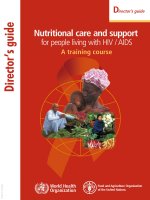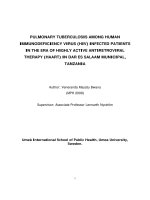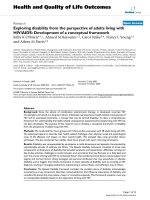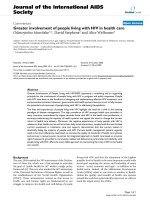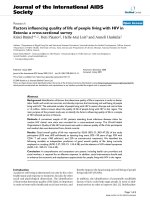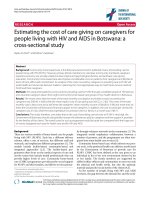Antiretroviral therapy (ART) adherence among people living with HIV AIDS (PLHIV) in the north of vietnam a multi method approach
Bạn đang xem bản rút gọn của tài liệu. Xem và tải ngay bản đầy đủ của tài liệu tại đây (4.44 MB, 268 trang )
ANTIRETROVIRAL THERAPY (ART) ADHERENCE
among People Living with HIV/AIDS (PLHIV)
in the North of Vietnam: a Multi-method Approach
Hoa Mai Do
MD, MPH
A thesis submitted for the degree of Doctor of Philosophy at the
School of Public Health, Faculty of Health, and Institute of Health
and Biomedical Innovation, Queensland University of Technology
2011
KEYWORDS
HIV/AIDS
Antiretroviral Therapy
Antiretroviral Therapy adherence
Antiretroviral
People Living with HIV/AIDS
HIV/AIDS patient
Multi-method/mixed method
Audio Computer-Assisted Self-Interview
Viet Nam
Level
Prevalence
Factors
Correlates
i
ii
ABSTRACT
The antiretroviral therapy (ART) program for People Living with HIV/AIDS
(PLHIV) in Vietnam has been scaled up rapidly in recent years (from 50
clients in 2003 to almost 38,000 in 2009). ART success is highly
dependent on the ability of the patients to fully adhere to the prescribed
treatment regimen. Despite the remarkable extension of ART programs in
Vietnam, HIV/AIDS program managers still have little reliable data on
levels of ART adherence and factors that might promote or reduce
adherence. Several previous studies in Vietnam estimated extremely high
levels of ART adherence among their samples, although there are reasons
to question the veracity of the conclusion that adherence is nearly perfect.
Further, no study has quantitatively assessed the factors influencing ART
adherence. In order to reduce these gaps, this study was designed to
include several phases and used a multi-method approach to examine
levels of ART non-adherence and its relationship to a range of
demographic, clinical, social and psychological factors.
The study began with an exploratory qualitative phase employing four
focus group discussions and 30 in-depth interviews with PLHIV, peer
educators, carers and health care providers (HCPs). Survey interviews
were completed with 615 PLHIV in five rural and urban out-patient clinics
in northern Vietnam using an Audio Computer Assisted Self-Interview
(ACASI) and clinical records extraction. The survey instrument was
carefully developed through a systematic procedure to ensure its reliability
and validity. Cultural appropriateness was considered in the design and
implementation of both the qualitative study and the cross sectional
survey.
The qualitative study uncovered several contrary perceptions between
health care providers and HIV/AIDS patients regarding the true levels of
ART adherence. Health care providers often stated that most of their
patients closely adhered to their regimens, while PLHIV and their peers
reported that “it is not easy” to do so. The quantitative survey findings
supported the PLHIV and their peers’ point of view in the qualitative study,
because non-adherence to ART was relatively common among the study
sample. Using the ACASI technique, the estimated prevalence of onemonth non-adherence measured by the Visual Analogue Scale (VAS) was
iii
24.9% and the prevalence of four-day not-on-time-adherence using the
modified Adult AIDS Clinical Trials Group (AACTG) instrument was 29%.
Observed agreement between the two measures was 84% and kappa
coefficient was 0.60 (SE=0.04 and p<0.0001). The good agreement
between the two measures in the current study is consistent with those
found in previous research and provides evidence of cross-validation of
the estimated adherence levels.
The qualitative study was also valuable in suggesting important variables
for the survey conceptual framework and instrument development. The
survey confirmed significant correlations between two measures of ART
adherence (i.e. dose adherence and time adherence) and many factors
identified in the qualitative study, but failed to find evidence of significant
correlations of some other factors and ART adherence. Non-adherence to
ART was significantly associated with untreated depression, heavy alcohol
use, illicit drug use, experiences with medication side-effects, chance
health locus of control, low quality of information from HCPs, low
satisfaction with received support and poor social connectedness. No
multivariate association was observed between ART adherence and age,
gender, education, duration of ART, the use of adherence aids, disclosure
of ART, patients’ ability to initiate communication with HCPs or distance
between clinic and patients’ residence.
This is the largest study yet reported in Asia to examine non-adherence to
ART and its possible determinants. The evidence strongly supports recent
calls from other developing nations for HIV/AIDS services to provide
screening, counseling and treatment for patients with depressive
symptoms, heavy use of alcohol and substance use. Counseling should
also address fatalistic beliefs about chance or luck determining health
outcomes. The data suggest that adherence could be enhanced by
regularly providing information on ART and assisting patients to maintain
social connectedness with their family and the community. This study
highlights the benefits of using a multi-method approach in examining
complex barriers and facilitators of medication adherence. It also
demonstrated the utility of the ACASI interview method to enhance open
disclosure by people living with HIV/AIDS and thus, increase the veracity
of self-reported data.
iv
TABLE OF CONTENT
KEYWORDS ......................................................................................................................i
ABSTRACT ......................................................................................................................iii
TABLE OF CONTENT ......................................................................................................v
LIST OF FIGURES ...........................................................................................................xi
LIST OF APPENDICES ..................................................................................................xii
LIST OF ABBREVIATION .............................................................................................xiii
STATEMENT OF ORIGINAL AUTHORSHIP ................................................................xvi
RELATED PRESENTATIONS AND PAPERS .............................................................xvii
ACKNOWLEDGMENT .................................................................................................xviii
CHAPTER 1: THESIS OVERVIEW...................................................................................1
1.1. Background of the Study ........................................................................................ 1
1.2. Purpose of the Study .............................................................................................. 3
1.3. Significance of the Study ........................................................................................ 4
1.4. Structure of the Thesis ........................................................................................... 4
CHAPTER 2: LITERATURE REVIEW ..............................................................................7
2.1. HIV/AIDS, Antiretroviral Therapy (ART) and Its Treatment Outcomes ................... 7
2.2. Challenges of ART Program, the High Level of ART Adherence Required
and the Consequences of Poor ART Adherence ........................................................ 10
2.3. Measurement of Adherence and the Prevalence of ART Adherence ................... 13
2.4. Factors Associated with ART Adherence ............................................................. 16
2.4.1. Contextual factors .......................................................................................... 17
2.4.2. Individual factors ............................................................................................ 22
2.5. Research on ART Adherence in Resource-poor Countries and Asia ................... 26
2.6. The Situation of HIV/AIDS and Research on ART Adherence in Viet Nam ......... 31
2.6.1. HIV/AIDS in Viet Nam .................................................................................... 31
2.6.2. ARV treatment, care and support programs for PLHIV in Viet Nam .............. 35
2.6.3. Research on ART adherence in Viet Nam .................................................... 39
2.7. Where to from Here: Research Questions, Survey Conceptual Framework,
Objectives and Hypotheses ......................................................................................... 41
v
CHAPTER 3. METHODOLOGY ......................................................................................45
3.1. Study Design ........................................................................................................ 45
3.2. Study Sites ........................................................................................................... 48
3.2.1. Dong Da hospital (provincial level) ................................................................ 48
3.2.2. Dong Anh outpatient clinic (district level) ....................................................... 49
3.2.3. Hai Duong provincial AIDS center (provincial level) ...................................... 49
3.2.4. Chi Linh and Kinh Mon out-patient clinics (district level) ............................... 49
3.3. Study Population, Sample Size and Data Collection Methods ............................. 50
3.3.1. Exploratory qualitative research .................................................................... 50
3.3.2. Cross-sectional survey .................................................................................. 53
3.4. Survey Instrument Development .......................................................................... 56
3.4.1. Expert consensus panel and individual feedback .......................................... 56
3.4.2. Focus group discussion with HIV/AIDS patients............................................ 59
3.4.3. ACASI software development ........................................................................ 60
3.4.4. Pilot study ...................................................................................................... 60
3.5. Survey Variable Measurement ............................................................................. 62
3.5.1. Outcome variables ......................................................................................... 62
3.5.2. Independent variables ................................................................................... 64
3.6. Measurement Quality of the Survey Instrument ................................................... 67
3.6.1. Test-retest reliability....................................................................................... 67
3.6.2. Internal consistency ....................................................................................... 71
3.6.3. Construct validity ........................................................................................... 73
3.7. Data Analysis and Management ........................................................................... 74
3.7.1. Exploratory qualitative data analysis ............................................................. 74
3.7.2. Survey data analysis...................................................................................... 75
3.8. Ethical Considerations .......................................................................................... 78
CHAPTER 4: QUALITATIVE FINDINGS ........................................................................81
4.1. Socio-demographic Characteristics of the Respondents ...................................... 81
4.2. Qualitative Data Analysis Framework ................................................................... 84
4.3. How do HIV/AIDS Patients Adhere to Their Regimen? ........................................ 85
4.4. Strategies that ARV Users Applied to Help Them to Adhere to their ART ........... 90
vi
4.4.1. Adherent aids ................................................................................................ 90
4.4.2. Adjust schedule of taking medication ............................................................ 90
4.4.3. Inappropriate behaviors ................................................................................. 91
4.5. Factors Influencing ART Adherence among PLHIV ............................................. 91
4.5.1. Gender and personal characteristics ............................................................. 91
4.5.2. Depression .................................................................................................... 93
4.5.3. Illicit drug use ................................................................................................. 93
4.5.4. Alcohol use .................................................................................................... 95
4.5.5. Treatment related factors .............................................................................. 95
4.5.6. Health service issues ..................................................................................... 97
4.5.7. Social and family factors .............................................................................. 100
CHAPTER 5: SURVEY FINDINGS ...............................................................................111
5.1. Characteristics of Study Participants .................................................................. 112
5.1.1. Socio-demographic characteristics .............................................................. 112
5.1.2. Characteristics of drug and alcohol use ...................................................... 114
5.1.3. Treatment and clinical characteristics.......................................................... 114
5.1.4. The use of adherent aids ............................................................................. 116
5.1.5. Respondents’ experiences with side-effects ............................................... 117
5.1.6. Descriptive statistics for depression and Chance Health Locus of
Control (HLC) Scales ............................................................................................. 119
5.1.7. Social and family characteristics ................................................................. 120
5.2. Level of Non-adherence to ART Among the Sample ......................................... 124
5.3. Factors Associated with ART Dose Non-adherence .......................................... 130
5.3.1. Univariate analysis ...................................................................................... 130
5.3.2. Multivariate logistic regression model of factors associated with dose
non-adherence ...................................................................................................... 134
5.4. Factors Associated with Time Non-adherence ................................................... 137
5.4.1. Univariate analysis ...................................................................................... 137
5.4.2. Multivariate logistic regression model of factors associated with time
non-adherence ...................................................................................................... 142
vii
CHAPTER 6: DISCUSSION AND CONCLUSION ........................................................149
6.1. Level of ART Non-adherence and the Use of ACASI Technique ....................... 149
6.2. Factors Associated with ART Adherence ........................................................... 151
6.2.1. Psychological and individual factors ............................................................ 152
6.2.2. Clinical and treatment related factors .......................................................... 156
6.2.3. Family and social factors ............................................................................. 160
6.3. Limitations of the Study ...................................................................................... 163
6.4. Significance and Implications of the Study ......................................................... 165
6.4.1. Study significance and implications for future studies ................................. 165
6.4.2. Public health and clinical practice ................................................................ 169
REFERENCES ..............................................................................................................173
APPENDICES ...............................................................................................................184
viii
LIST OF TABLES
CHAPTER 2
Table 2.1. Summary Literature Review of Quantitative Study on ART Adherence
Conducted in Asian Countries…………………………………………………………..
28
CHAPTER 3
Table 3.1: Matrix for Sampling in Qualitative Research……………………………
51
Table 3.2. Survey Sampling Process…………………………………………………
55
Table 3.3. Prevalence and Test-retest Reliability of Outcome and Categorical
Variables…………………………………………………………………………………
69
Table 3.4. Test-retest Reliability of Self-reported Continuous Independent
Variables………………………………………………………………………………….
70
Table 3.5. Cronbach alpha of Continuous Variables………………………………..
72
Table 3.6. Summary of the Fit Statistics of Models…………………………………..
73
CHAPTER 4
Table 4.1: Socio-demographic Characteristics of Respondents…………………….
83
CHAPTER 5
Table 5.1. Characteristics of the Sample..............................................................
113
Table 5.2. Alcohol & Drug Use…………………………………………………………
114
Table 5.3. Treatment Characteristics of the Sample...........................................
115
Table 5.4. Clinical Characteristics of the Sample................................................
116
Table 5.5. The Use of Adherence Aids………………………………………………..
117
Table 5.6. Experiences of Side-effects of the Sample………………………………
118
Table 5.7. Experience with Depression Symptom among the Sample................
119
Table 5.8. Descriptive Statistics of Chance Health Locus of Control..................
120
Table 5.9. Categorical Family and Social Factors…………………………………
121
Table 5.10. Continuous Family and Social Factors…………………………………
122
Table 5.11. Descriptive Statistics of Friendship Scale……………………………..
123
Table 5.12. Descriptive Statistics of Modified Patient Reactions Assessment
(PRA) Scale .........................................................................................................
124
Table 5.13. Agreement between Two Measures of ART adherence……………..
127
Table 5.14. Characteristics of ART adherence among sample……………………
128
Table 5.15. Reasons for not taking medication on time or missing doses............
129
ix
Table 5.16. Univariate analysis of socio-demographic factors by dose nonadherence.............................................................................................................
130
Table 5.17. Univariate analysis of clinical and treatment factors by dose nonadherence.............................................................................................................
131
Table 5.18. Univariate analysis of alcohol and drug use by dose nonadherence..............................................................................................................
132
Table 5.19. Univariate analysis of depression, side–effect experience and health
locus of control by ART dose non-adherence............................................
133
Table 5.20. Univariate analysis of continuous social factors by dose nonadherence.............................................................................................................
134
Table 5.21. Multivariate analysis of factors associated with dose non-adherence
measured by VAS ……………………………………………………………………...
136
Table 5.22. Univariate analysis of socio-demographic factors by time nonadherence.............................................................................................................
138
Table 5.23. Univariate analysis of clinical and treatment factors by time nonadherence................................................................................................................ 139
Table 5.24. Univariate analysis of alcohol and drug use by time nonadherence..............................................................................................................
140
Table 5.25. Univariate analysis of depression, experience of side –effects and
health locus of control by time non-adherence...............................................
141
Table 5.26. Univariate analysis of involvement in PLHIVs’ groups by time nonadherence.............................................................................................................
141
Table 5.27. Univariate analysis of social factors by time non-adherence............
142
Table 5.28. Multivariate analysis of factors associated with time non-adherence
measured by AACTG…………………………………………………………………….
143
Table 5.29. Summary of the factors associated with ART non-adherence by two
measurements in multivariate analysis..................................................................
146
x
LIST OF FIGURES
CHAPTER 2
Figure 2.1. Estimated number of AIDS-related deaths with and without
antiretroviral therapy globally, 1996-2008………………………………………….
9
Figure 2.2. Estimated number of life-years added due to antiretroviral therapy by
region, 1996-2008........................................................................................
10
Figure 2.3. Price of ARVs in Viet Nam in 2008……………………………………
12
Figure 2.4: Literature Mapping on ART Adherence among PLHIV……………..
18
Figure 2.5. Reported Cumulative HIV Infections, AIDS Cases, and AIDS Deaths,
1995-2009…………………………………………………………………...
32
Figure 2.6. Distribution of reported HIV cases by sex and by year, 199333
2009…………………………………………………………………………………………..
Figure 2.7. Distribution of reported HIV cases by age group and by year,
1993- 2009…………………………………………………………………………….
33
Figure 2.8. HIV prevalence among IDUs in Viet Nam 1996-2009………………
34
Figure 2.9. HIV prevalence among female sex worker in Viet Nam 1996- 2009.
34
Figure 2.10. National spending on HIV/AIDS by categories, 2007-2009……….
37
Figure 2.11. The Number of Adults and Children on ART in Viet Nam, 2006-2009…
………………………………………………………………………………….
Figure 2.12. Survey Conceptual Framework………………………………………
38
42
CHAPTER 3
Figure 3.1. Study Flow Diagram………………………………………………….
47
Figure 3.2. Bland-Altman plot of depression…………………………………....
71
CHAPTER 5
Figure 5.1. VAS scale distribution....................................................................
125
Figure 5.2. AACTG adherence distribution......................................................
126
xi
LIST OF APPENDICES
1 Appendix A. Viet Nam at a Glance…………………………………………...
185
2 Appendix B. Viet Nam Map and Location of Study Sites…………………..
17
3 Appendix C. Guideline for exploratory qualitative…………………………..
189
4 Appendix D. List of international and national expert providing feedback
on study …………………………………………………………………………
205
5 Appendix E. Final Survey Questionnaire ……………………………………
207
6 Appendix F. Bland – Altman Plots……………………………………………
229
7 Appendix G. Ethical Approval from Queensland University of
Technology in Australia………………………………………………………
236
8 Appendix H. Ethical Approval from Hanoi School of Public Health in Viet
Nam…………………………………………………………………………….
239
9 Appendix I. NVivo software tree node ……………………………………….
241
10 Appendix K. Pictures of ACASI instruments, study sites, and data
collection…………………………………………………………………………
243
xii
LIST OF ABBREVIATION
AACTG
Adult AIDS Clinical Trials Group
ACASI
Audio Computer-Assisted Self-Interview
ACSPRI
Australian Consortium for Social and Political Research
Incorporated
AIDS
Acquired Immune Deficiency Syndrome
AMOS
Analysis of Moment Structure
ANOVA
Analysis Of Variance
ART
Antiretroviral Therapy
ARV
Antiretroviral
AZT
Zidovudine (formerly called azidothymidine)
BA
Bachelor of Art
BDI
Beck’s Depression Inventory
CDC
Center for Disease Control and Prevention
CES-D
Center for Epidemiological Studies Depression
CFA
Confirmatory Factor Analysis
CFI
Comparatives Fit Index
CHLC
Chance Health Locus of Control
CI
Confidence Interval
CPCRA
Community Programs for Clinical Research on AIDS
DNA
Deoxyribonucleic acid
DOT
Direct Observed Treatment
EDM
Electronic Drug Monitoring
ESTHER
The Ensemble pour une Solidarité Thérapeutique Hospitalière
FGD
Focus Group Discussion
FHI
Family Health International
FSWs
Female Sex Workers
GFATM
The Global Fund for AIDS, Tuberculosis and Malaria
GFI
Goodness of Fit Index
GIPA
Greater Involvement of People with HIV/AIDS
HAART
Highly Active Antiretroviral Therapy
HIV
Human Immunodeficiency Virus
HLC
Health Locus of Control
HSPH
Hanoi School of Public Health
IBBS
Integrated Biological and Behavioral Surveillance
ICC
Intraclass correlation coefficients
xiii
IDUs
Injecting Drug Users
IHBI
Institute of Health and Biomedical Innovation
IHLC
Internal Health Locus of Control
IMB
Information, Motivation and Behavioral skills
IRIS
Introduction Research for International Students
KAP
Knowledge Attitude and Practice
LIFE-GAP
Leadership and Investment in Fighting an Epidemic –
Global AIDS Program
MBBS
Bachelor of Medicine, Bachelor of Surgery
MD
Medical Doctor
MHLC
Multidimensional Health Locus of Control
ML
Maximum Likelihood
MOH
Ministry of Health
MOU
Memorandum Of Understanding
MPH
Master of Public Health
MSM
Men who have Sex with Men
NAP
The National AIDS Program
NCADPPC
The National Committee for AIDS, Drug and Prostitution
Prevention and Control
NGOs
NNR
Non-Government Organizations
TIs
Non-Nucleoside Reverse Transcriptase Inhibitors
NRTIs
Nucleoside Reverse Transcriptase Inhibitors
OIs
Opportunistic Infections
PAI
Patient Affective Index
PCI
Patient Communication Index
PEPFAR
The President's Emergency Plan for AIDS Relief
PhD
Doctor of Philosophy
PHLC
Powerful Others Health Locus of Control
PII
Patient Information Index
PIs
Protease Inhibitors
PLHIV
People Living with HIV/AIDS
PRA
Patient Reaction Assessment
QUT
Queensland University of Technology
RMSEA
Root-Mean-Square Error of Approximation
SD
Standard Deviations
SDT
Self-Determination Theory
SEM
Structural Equation Modeling
xiv
SPSS
Statistical Package for the Social Sciences
SST
Self Supervised Treatment
TB
Tuberculosis
UNAIDS
The United Nations Joint Program on HIV/AIDS
USA
The United States of America
VAAC
The Viet Nam Administration of AIDS Control
VAS
Visual Analogue Scale
VCT
Voluntary Counseling and Testing
WHO
World Health Organization
xv
STATEMENT OF ORIGINAL AUTHORSHIP
The work contained in this thesis has not been previously submitted to meet
requirement for an award at this or any other higher education institution. To the
best of my knowledge and belief, this contains no material previously published
or written by another person except where due reference is made.
Hoa Mai Do
Date: February 18th 2011
xvi
RELATED PRESENTATIONS AND PAPERS
Conference Papers
Hoa Do, Michael Dunne, Masaya Kato, Kinh Nguyen. Antiretroviral Therapy
Adherence among People Living with HIV/AIDS in the North of Vietnam: A
qualitative study (The 4th International Conference on HIV Treatment Adherence,
Miami, USA, April 5th-7th, 2009)
Hoa M. Do, Michael P. Dunne, Cuong V. Pham, Masaya Kato. Non-adherence to
Antiretroviral Therapy in Viet Nam: Prevalence and clinical, social and
psychological correlates (The 18th International AIDS Conference, Vienna,
Austria, July 18th-23th, 2010)
Papers
D.M.Hoa, L.B. Chau, P.T. Linh et al. Model of care and support for people living
with HIV/AIDS in Hai Chau district, Da Nang city. Vietnam Journal of Public
Health. 2009. 12(6)
B.T.Mai, D.M.Hoa, L.B. Chau et al. Care and support for people living with
HIV/AIDS in Hai Chau and Thanh Khe district in Danang city in 2006. Vietnam
Journal of Public Health. 2007. 3(9)
Linh Cu Le, Robert W. Blum, Robert Magnani, Paul C. Hewett, and Hoa Mai Do.
A pilot of audio computer-assisted self-interview (ACASI) for youth reproductive
health research in Vietnam. Journal of Adolescent Health, 38. 2006: 740-747
xvii
ACKNOWLEDGMENT
I would like to express my gratitude to all who have helped me to
accomplish this thesis and my study at the Queensland University of Technology
(QUT). First and foremost I would like to thank Prof. Michael Dunne, my principal
supervisor, for his interest in this study, his excellent ideas, and his dedication to
reading and providing comments on multiple drafts of my thesis. He also
encouraged and guided me to be able to steer my academic study and
professional development throughout my PhD program. I would also like to thank
Prof. Gerard Fitzgerald and Dr. Nguyen Van Kinh, my Associate Supervisors, for
their time and great comments on this thesis. I would like to express my gratitude
to Dr. Masaya Kato from World Health Organization Representative Office in
Vietnam, who provided me a realistic perspective to my thesis and his continuous
expertise throughout this process. I would like to extend my appreciation and
thanks to Dr. Pham Viet Cuong, Prof. Everarda Cunningham, Dr. Diana Batistutta
and Dr. Cameron Hurst, for their statistical supports. Special appreciation and
thanks to Sonja Firth, who has spent time and effort providing editorial support. I
am also very thankful to Jill Nalder for helping, encouraging, and sharing
emotions during my study at QUT.
This study would have never happened without the support of the Hanoi
School of Public Health (HSPH), and I appreciate the contributions from the
Dean, Prof. Le Vu Anh, and my colleagues at the HSPH who helped make the
research a success. Thanks to Dr. Masami Fujita, Dr. Julian Elliott, Dr. Rachel
Burdon, Prof. Krishna Poudel, Dr. Do Thi Thanh Nhan, Ass.Prof. Le Cu Linh, Dr.
Nguyen Thanh Huong, Dr. Do Duy Cuong, Dr. Vu Thi Bich Diep, Dr. Cao Thi
Thanh Thuy, Ms. Nguyen Thi Minh Thu for their constructive comments on the
questionnaire, protocol and manuscripts. I wish to thank Tran Hong Quang and
Pham Thuy Linh for their helps in developing the ACASI software. Special thanks
to my research assistants, Le Minh Hai, Nguyen Minh Hoang, Le Thi Thu Huyen,
Nguyen Thi Hoang Nga, Le Bao Chau, Le Thi Thu Ha for their assistance in data
collection. To all the faculty, staff and PhD colleagues at the QUT and the HSPH
whom I could not possibly mention in detail, a big thank you for your supports.
xviii
This study will not be successful without the cooperation of many kinds of
souls. Special thanks are due to all committed directors and dedicated staff in
five out-patient clinics for their cooperation and facilitations to smoothly complete
my fieldwork portion of this study. There were many people in Hanoi and Hai
Duong whom I would like to thank for their willingness, patience and time to
participate in this study.
I would like to thank the Australian Leadership Awards (ALA) Scholarship
of the Australian Agency for International Development (AusAID), the World
Health Organization (WHO) Representative Office in Vietnam, and the Hanoi
School of Public Health (HSPH) for their financial supports that made this study
possible. The ALA Scholarship has offered educational experiences on research
and leadership training that has allowed me to both shape my career path and
become friends with some of the most interesting and admirable people I have
ever known.
Last but certainly not least, to my family, I would like to thank my parents,
sisters and brothers for their continuing support in countless ways, as well as my
friends who understood and put up with me during this stressful time period. To
my husband, Cuong, I am grateful for his unending support and patience
throughout the implementation of this thesis and my education. Without his
emotional and mental support, I could not have successfully completed my PhD
degree. Bim and Chick, my lovely son and little daughter, I am done and I am
coming home. I love you so much and I am proud of you both.
xix
CHAPTER 1: THESIS OVERVIEW
1.1. Background of the Study
The1 increased availability of treatment has dramatically improved survival rates
and lowered the incidence of opportunistic infections in People Living with
HIV/AIDS (PLHIV)
2
. Antiretroviral Therapy (ART) has been shown to
successfully decrease viral loads and increase CD4 cell count
3-5
. A dramatic
reduction in HIV related morbidity and mortality has been observed in countries
where ART has been made widely available
6, 7
. Whilst there are many benefits
to ART, there are also many challenges caused by this therapy. One of these
challenges is that very high levels of adherence to ART (at least 95%) are
needed to ensure optimal benefits
3, 7, 8
. Many studies have revealed that poor
adherence can lead to failure to reduce viral load, the evolution of drug
resistance and subsequent immunological and clinical failure 3, 4, 6.
Although the measurement of ART adherence is critically important in both ART
interventions and clinical research, there is no “gold standard” by which to
measure adherence to medication
9-12
. While adherence can only be ensured by
directly observed treatment, this is not practical for daily therapy which has to be
taken for the whole of a patient’s life. As a result, levels of adherence can only be
estimated by use of indirect measures
13
. These measures include self-reporting
tools (such as questionnaires and visual analogue), pill counts, pharmacy refill
records and electronic drug monitoring devices. However, all methods have
strengths and weaknesses
9-12
. The most common approach is to elicit the
information by self-report, in which participants describe their adherence over a
specified time interval. It appears that self-report methods may lead to an
overestimation of medication adherence, but they are often used because they
are inexpensive and feasible in a wide variety of settings
14
. More importantly,
many studies have shown that self-report assessment, visual analogue scale,
electronically monitored doses, and pill count lead to similar estimates of the
relationship between adherence and viral suppression and adherence is a strong
predictor of viral load 3, 15, 16.
1
Most of the studies on ART adherence have been conducted in North America,
Europe and African countries, but not many have been conducted in Asia. There
are considerable variations in ART adherence levels between countries as well
as within a country. A meta-analysis conducted by Mills et al (2008) for 31
studies (17 573 patients total) conducted in North America indicated a pooled
estimate of 55% (range: 26%-86%) of the population achieving adequate levels
of adherence, while the result of the analysis of 27 studies (12 116 patients total)
conducted in sub-Saharan Africa indicated a pooled estimate of 77% (range:
30%-100%), indicating a significantly (P<0.001) higher level of adherence in
Africa
17
. The literature review of this current study (Chapter 2) found that the
proportion of PLHIV who achieve optimal adherence in Asia was even higher
than in Africa
18, 19
. The potential reasons for the high level of adherence in Asia
are discussed, including biases caused by the influence of healthcare providers
20, 21
and the fear by patients that their treatment will be interrupted if they admit
to poor adherence practice22. Current studies in Viet Nam have also highlighted
these problems
23
and drawn attention to the need for a better approach to data
collection. A method such as Audio Computer-Assisted Self-Interview (ACASI),
that maximizes patients’ anonymity, minimizes the influence of health care
providers in the data collection process and eases patients’ concerns about the
impact of the interview on their treatment 14, might be appropriate.
Researchers have identified numerous factors influencing ART adherence
among PLHIV17. There are different ways to group the factors that influence
adherence to ART. The simplest way distinguishes between individual and
contextual factors. The contextual factors include treatment related issues
(complexity of regimen side-effects, accessibility, patient-provider relationship,
quality of services, etc.), and social interaction (disclosure, types of support,
sources of support, satisfaction level, social capital, etc.). On the other hand,
many individual factors were reported to be important in influencing adherence to
ART. These factors comprise socio-demographic characteristics and risk
behaviors such as drug use, alcohol use and mental health problems.
Understanding the factors that influence adherence to ART is essential for
designing strategies to optimize adherence. The evidence has been growing
rapidly in resource-rich settings as well as in some resource-poor settings, but is
2
lacking in Viet Nam. Despite the remarkable scaling up of ART programs in Viet
Nam
24
, HIV/AIDS program managers still have little reliable data on levels of
ART adherence and factors that might facilitate or impede adherence to ART.
Three studies on ART in Viet Nam estimated extremely high levels of ART
adherence among their samples (from 85% to 100% of participants were optimal
ART adherers)22,
23, 25
. Official reports from out-patients clinics also generally
underestimated ART non-adherent practice due to factors that inhibit patients’
honesty in reporting their non-adherent practices (fear of consequences) and
failure of professionals to recognize and report non-adherence. Further, no study
has quantitatively assessed the factors influencing ART adherence. Hence, this
study aims to partially fill the gaps in the literature on adherence to ART.
Specifically, the result of this doctoral study should increase the level of
understanding of ART adherence and its associated factors among PLHIV in the
North of Viet Nam.
1.2. Purpose of the Study
This study was conducted across several phases and used a multi-method
approach. First, a qualitative study employed 4 focus group discussions and 30
in-depth interviews with HIV/AIDS patients, peer educators, carers and medical
staff. Second, a survey was used to collect data from 615 HIV/AIDS patients on
ART in five rural and urban out-patient clinics in Viet Nam using an Audio
Computer Assisted Self-Interview (ACASI) and clinical record extraction. This
study aims to answer the following questions:
1. To what extent do PLHIV in the North of Viet Nam adhere to their
Antiretroviral (ARV) regimens?
2. What individual, family and clinical factors influence ART adherence
among PLHIV in the North of Viet Nam?
3. What are the practical implications for intervention programs to improve
ART adherence?
3
